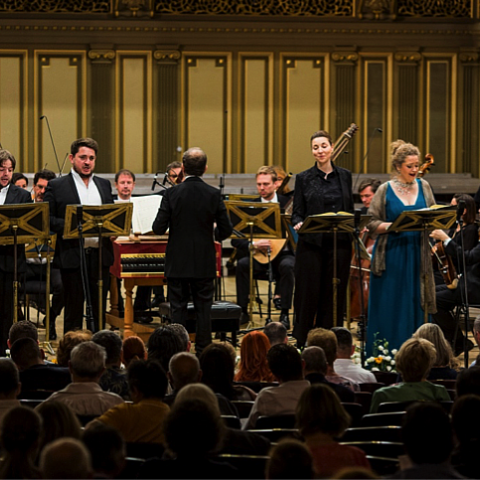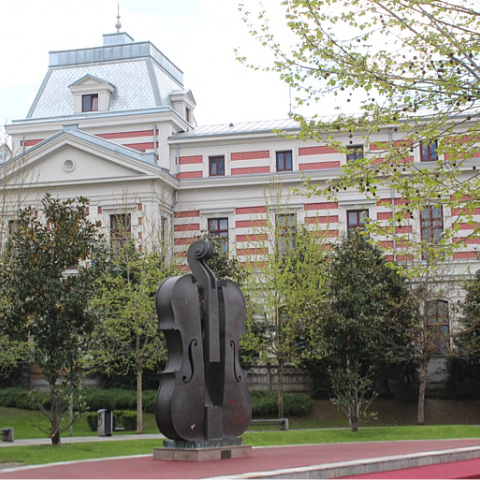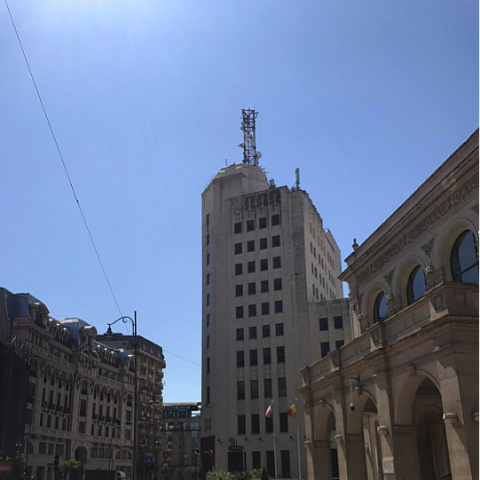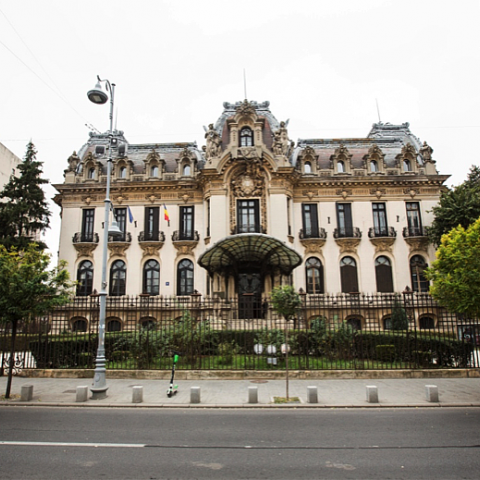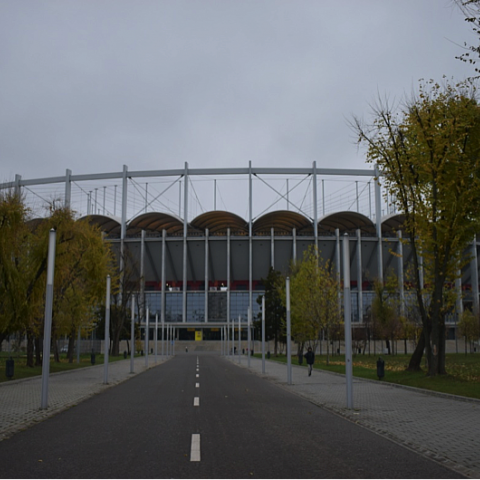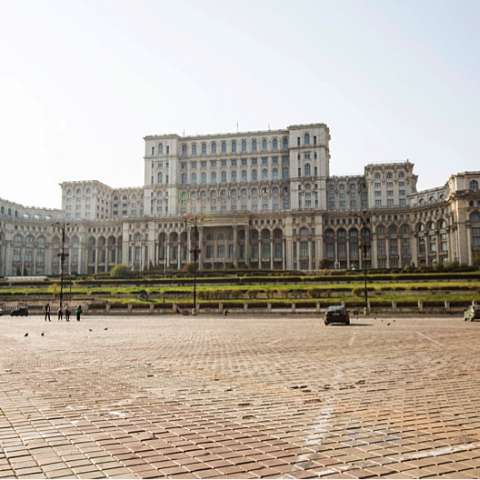"Destination: Bucharest" - The music of yesterday and today in the Capital city
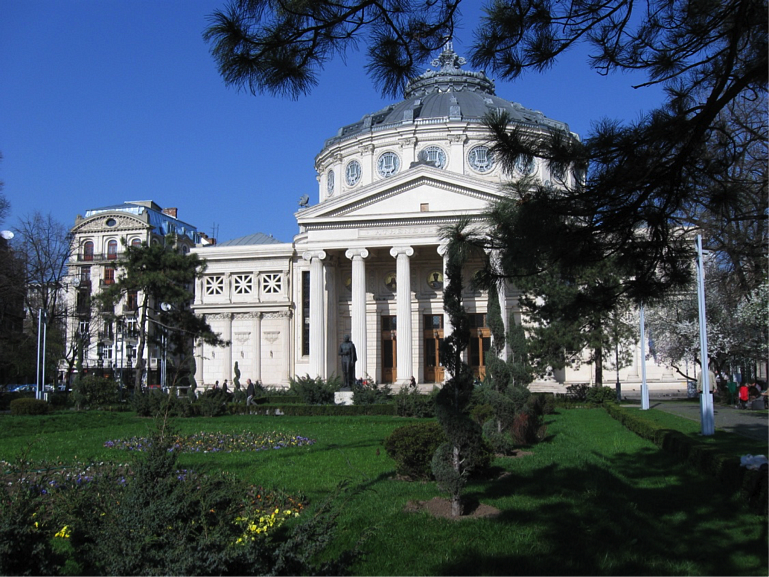
The rhythm of the city changed from one decade to another, in tune with the changes Bucharest went through, but music remained one of its constants. We start a musical journey and discover the moment when the community gathered to support the construction of the Romanian Athenaeum, the city where lovers sang serenades under balconies and arranged dates in Cișmigiu Park, but also the neighborhoods that inspired today's artists.
We start our walk at the Anton Pann Memorial House, which opened in 2018, on a street close to Sfânta Vineri Square, in the area of the former Jewish neighborhood. The museum is dedicated to the poet and composer who is credited with the music of the national anthem of Romania – “Deșteaptă-te, române!” (Awaken, Romanian!). Pann lived in Bucharest beginning with 1812 and he left behind some of the most valuable testimonies about the city during the first half of the 19th century. The oriental tastes and habits and the western influence were blending in the urban texture of the city of the time and part of that spirit is captured in the songs Pann included in the volume “Spitalul amorului sau Cântătorul dorului” (The Hospital of Love or the Singer of Longing). Among them is “Până când nu te iubeam” (Until I didn’t love you), which became a local hit performed by Maria Tănase and was recently covered by Pink Martini. The song “Arză-l focul, dascăl” (Damn, that teacher) is also part of Pann’s collection, and was included on the soundtrack of the movie Aferim!. The film, directed by Radu Jude, received in 2015 the Silver Bear at the International Berlin Film Festival (Berlinale). The film is set in 1835 Wallachia and tackles the topic of the enslavement of the Roma, whom the revolutionaries of 1848 wanted released.
In December 1846 and January 1847, Bucharest lived another memorable moment of its musical history, namely the concerts delivered by Hungarian composer and pianist Franz Liszt. The concerts were part of a tour that also took the musician to Timişoara, Lugoj, Arad, Sibiu, Cluj, Aiud and Iaşi.
Another 40 years passed since Liszt’s visit until the start of the construction works on the edifice that is today considered a symbol of Bucharest and an unmissable spot for classical music lovers: the Romanian Athenaeum. The building of the Athenaeum was erected with the money raised in a public subscription, which ran under the slogan “Dați un leu pentru Ateneu!”(Give a penny for the Athenaeum!). French Albert Galleron designed the architecture, inspired by the ancient Greek temples. The Athenaeum hosts the George Enescu Philharmonic, which bears the name of the composer, violinist and pianist regarded as the most important Romanian musician. We find the Athenaeum quiet, waiting for the next concert to start. A few youngsters are sitting on the entrance stairs, waiting for their date partners, and, on one side, a group of what appear to be tourists exploring the city, are listening to the explanations of their guide.
Outside of the regular season of the George Enescu Philharmonic, the Athenaeum also hosts a series of concerts that are part of the George Enescu International Festival, the largest event dedicated to classical music organized locally. Another series of festival concerts take place at Sala Palatului, the nearby building behind the National Museum of Art of Romania. The festival, which takes place once every two years, brings to Bucharest top orchestras and well-known soloists. Throughout the three weeks it takes place, the entire area is animated by the agitation of the public rushing to get to the concerts, coming from Calea Victoriei or from the Athenaeum to reach Sala Palatului, and the luckiest ones can even catch a glimpse of classical music stars out for a walk in the city.
George Enescu Square is also the meeting place of lovers of music of all genres. The concerts of the Bucharest International Jazz Festival take place here. The free-entrance event offers the public the opportunity to see some of the biggest names of international jazz but also established local artists. The events that are part of the light festival Spotlight also take place here, and last year the square hosted the concert of French DJ Bob Sinclar.
Calea Victoriei runs on one side of Enescu Square and on it, a little further down from the Kretzulescu Church, towards the Telephone Palace, we find the Muzica Store, a landmark for music enthusiasts or professionals who want to purchase instruments or music equipment. Nearby, we find the sidewalk in front of the bust of Corneliu Coposu taken up by skaters practicing their moves.
Also on Calea Victoriei, but further up towards Victoriei Square, Cantacuzino Palace, the headquarters of the George Enescu National Museum stands. The beautiful Cantacuzino Palace, built according to the plans of architect Ion D. Berindey in the style of French Baroque, belonged to politician Gheorghe Grigore Cantacuzino, a former prime minister of Romania. After his death, the palace was inherited by his son, Mihai, who then passed it on to his wife Măruca, who married George Enescu in 1939. The museum opened in 1956 and visitors can also see the memorial house behind the palace, where Enescu and Măruca Cantacuzino lived. The museum’s collection encompasses many items that belonged to the maestro, such as musical instruments, scores, photographs, manuscripts, gathered in a display that is meant to help visitors find out more about the personality of the composer of the Romanian Rhapsody and of Oedip.
Calea Victoriei still hosts many of the villas and palaces where the poshest balls of the city used to take place in the period between the two world wars. The same artery used to host once many gardens and terraces which lured the public in not only with appetizing menus but also with a music program delivered by the top singers of the time. One of the best-known and liked by the public in the interwar period was Cristian Vasile. He could be heard at Grand Restaurant and at the well-known Lafeyette, both found on Calea Victoriei, or at the summer garden La Bufet, located at the time in the vicinity of the Telephone Palace. Vasile would sing and charm the public every night with songs such as “Zaraza”, “Iubesc femeia” (I love women), “Pe boltă când apare luna” (When the moon rises in the sky) or “Aprinde o țigară” (Light up a cigarette). Composed by Benjamin Tagle Lara, with lyrics by Ion Pribeagu, Zaraza became one of the most popular tangos of the time.
Another performer well-liked by the public was Jean Moscopol. Born in Brăila, he worked as a clerk in a bank before rising to fame. The public could listen to him at Colonade, at Lafayette, and at Vișoiu garden. His recordings preserved for today’s audiences songs like “Vrei să ne-ntâlnim sâmbătă seară” (Do you want to meet this Saturday evening), a negotiation on the best day for a date “in a small dinner on the big road.” “La șosea” (on the road) was the term used to refer to Kiseleff Boulevard, a place for walking and socializing at the time. It was also the place where the “flower fights” would take place, events where flowers were thrown at the carriages on the road.
Moscopol used to charm Bucharesters with another song that is still popular today – “Te aștept diseară-n Cișmigiu” (I’m waiting for you tonight in Cișmigiu), a romantic message of a lover recalling the love story that took place against the background of the park located in the downtown area of the city. Another hit of the time he performed was “Violete pentru fete” (Violets for the girls), a song where two of the characters are the gypsy girl picking flowers “from the enchanted garden/ of love stories” and the flower seller reminding lovers that the violets for the girls “bloom out of love.”
The public of that time would also enjoy listening to Zavaidoc, the stage name of Marin Teodorescu, derived from the regional term “zavaidoacă”, which references a cheerful, prankish man. During the First World War, he performed for the wounded in hospitals, just as George Enescu and opera singer Elena Zamora did. After the war, the 1920s and 1930s find him performing at famous gardens and terraces of the city songs such as “Cântecul lui Zavaidoc” (The Song of Zavaidoc), “De când m-a aflat mulțimea” (Since the crowds got to know me), “Dragostea e ca o râie” (Love is an itch) or “Mărie și Mărioară” (Mărie and Mărioară).
In his turn, Dorel Livianu, another famous performer of the interwar period, left behind a high number of recordings. His repertoire included romance songs (romanțe), tangos, foxtrot songs, but also Romanian folk songs. Among the most popular songs he performed are “Ce frumoasă este viața” (How beautiful life is), “În micul orășel uitat de lume” (In a small, world-forgotten town), “Ionel, Ionelule” and “Ce faci astă seară tu?” (What are you doing tonight?), the latter describing the insecurities and torment of the lover wanting to find out if he will get the rendez-vous he hopes for.
The feel of the interwar Bucharest was also preserved in the recordings left from Titi Botez, known for “Trurli, trurli”, a song that has been reinterpreted, mixed and performed numerous times since the first version was launched, or “Sub balcon eu ţi-am cântat o serenadă” (I sang a serenade under your balcony), a romantic declaration of love.
Singer Maria Tănase, often referred to as the “Edith Piaf of Romania”, started her career in the interwar period. He performed an impressive repertoire of popular songs, among the best known being “Cine iubește și lasă” (He who loves and lets go), “M-am jurat de mii de ori” (I swore a thousand times), “Șapte săptămâni din post” (Seven weeks of fasting), “Ce-i mai dulce ca alvița” (What is sweeter than candy), “Geaba mă mai duc acasă” (I go home for nothing), “Mărie and Mărioară.” In between 1930 and 1940, the public could listen to her in Bucharest venues such as Café Wilson, Capşa, Luther, Continental, Manuc’s Inn or Neptun, the latter a favorite meeting place for many writers of the time. In 1958, the artist recorded three songs from the soundtrack of the short “Memories from Bucharest,” produced to mark 500 years since the first documentary mention of the city. The music was composed by Temistocle Popa and Gherase Dendrino, and Maria Tănase performs three songs: “Mărioară de la Gorj” (Mărioară from Gorj), „Badea neichii, Bucureşti” (Hello, Old Bucharest) and “În Târgul Moşilor” (At the Moşilor Fair), the latter a reference to the event also called Moșii (La Moși) or the May Fair, a yearly fair organized in the area of the Obor market, starting with the end of the 18th century and up to the second half of the 20th century.
The city and its slums also found a place in the songs performed by Gică Petrescu, a singer whose career spanned more than six decades, starting with 1933 up to 2006. “La Crâșma din Ferentari” (At the Ferentari joint) and “La margine de București” (On the outskirts of Bucharest) are two of the songs celebrating the charm of the marginal areas, from a repertoire that included hits such as “Căsuța noastră” (Our house), “Dă-i cu șprițul pân' la ziuă” (Keep drinking till morning comes), “Uite-așa aș vrea să mor” (This is how I would like to pass away) or “Du-mă acasă măi tramvai” (Take me home, tram), recorded between 1966 and 1971, and reinterpreted in several versions event today.
Today’s Calea Victoriei no longer echoes the sound of tangos but music has remained a constant here, either in the concert halls or at the terraces and clubs în the area, including a popular one where jazz, blues, alternative music and theater evenings are held regularly.
The city’s historic areas and landmarks resurfaced, in time, in contemporary music. In 1988, Romanian composer and singer Nicu Alifantis launched the album “Piaţa Romană nr. 9” (9 Romană Square). Alexandru Andrieş authored the lyrics of the song of the same name and reference the place where Alifantis used to live and work.
Years later, local group Vama Veche did a cover after the well-known hit “Hotel California,” dedicated this time to the Cișmigiu Hotel, located close to the park of the same name. The song hints to the period when the hotel was used as a student dormitory. The building of the hotel, erected in 1912, was listed as a historical monument and is a landmark of the Regina Elisabeta Boulevard. After it was restored and reopened in 1912, the building now hosts the Cișmigiu Hotel, the headquarters of the Cervantes Institute, an elegant library, and Gambrinus Beerhouse, whose décor gives visitors a glimpse of the Little Paris atmosphere.
In another song, the group refers to another landmark of the city – the subway. The song opens with the message “Attention, doors closing,” an announcement well-known to commuters, and describes a growing-up process that leaves too little room for dreaming – “In the morning/ I take the subway/ you know what’s there/ nothing is new.”
The city’s „dormitory neighborhoods”, built during communism, are the background for many of the hits released in the period that followed the 1989 revolution. Parties moved from the main road into the neighborhood, as we can hear in B.U.G. Mafia’s “Pantelimonu' petrece” (Pantelimon is partying), while the most prosaic activities become the topic of bossa nova hits, as is the case with “Violeta”, a song by Sarmalele Reci.
With the headphones of the iPod on, we end our music-related walk. Vinyl records and streaming apps replaced the old ebonite discs and the gramophone, but music is still very much a part of the life of the city, on its streets and in its clubs, in the downtown squares or behind the remote blocks of flats.
Useful:
Other Bucharest venues where concerts with a large public take place are Constituției Square, where the Bon Jovi concert took place in 2019, and the National Arena, which hosted last year the concert of Ed Sheeran and where Celine Dion is expected to perform this summer.
Electrecord, the biggest and oldest record house in the country, launched in 2016 an audio streaming app giving users access to its archive or recordings. The app is available in both Google Play and in Apple Store. A part of the Electrecord archive, which includes recordings by Cristian Vasile, Zavaidoc, Titi Botez, Gică Petrescu or Maria Tănase, is also available on the company’s YouTube channel.
Throughout the period of the Covid-19 restrictions, several institutions including the Bucharest National Opera (ONB) and the George Enescu Philharmonic offer live-streamed concerts and performances from the archives of the two institutions. The concerts are streamed on the Facebook page and YouTube channel of the Philharmonic. ONB streams the performances on its website and Facebook page. The program of performances is updated on the two institutions’ social media channels and websites. At the same time, several opera houses and philharmonic orchestras in the country offer online concerts, among them the Iași National Opera, the Romanian National Opera in Cluj-Napoca, and the Paul Constantinescu Philharmonic in Ploiești.
George Enescu International Festival offers recordings of concerts from the previous editions of the event and of the associated competition. The concerts are available on the festival’s website, where they can be watched, for free, for four days, after which the program is renewed.
The Overground Showroom platform, launched at the beginning of April, offers subscribers concerts of Romanian bands. Among the productions currently available are performances of byron, The Mono Jacks, Luna Amară, Diamonds are Forever and Melting Dice.
This material is part of a project under the program of promoting the touristic heritage "Destination: Bucharest", carried out by the Bucharest City Hall through the Public Monuments and Touristic Heritage Administration (AMPT).
Photos by Romania-Insider.com for AMPT.








